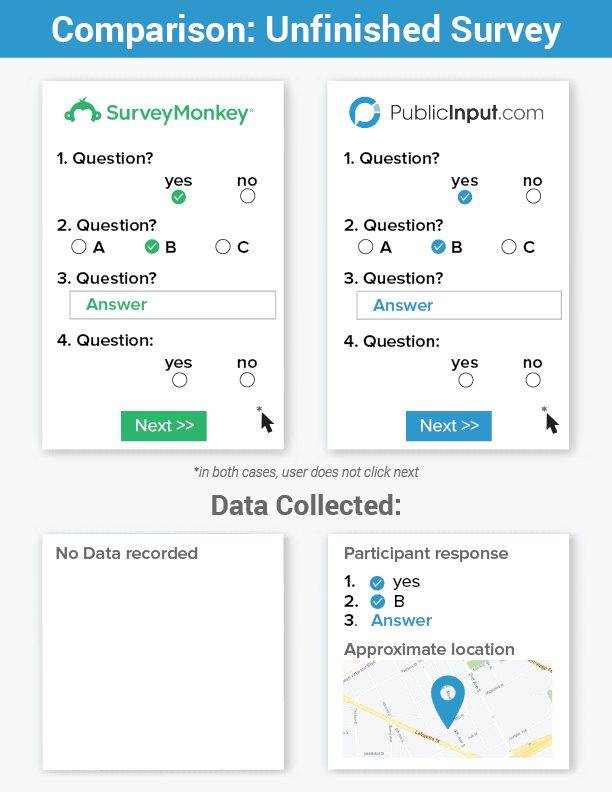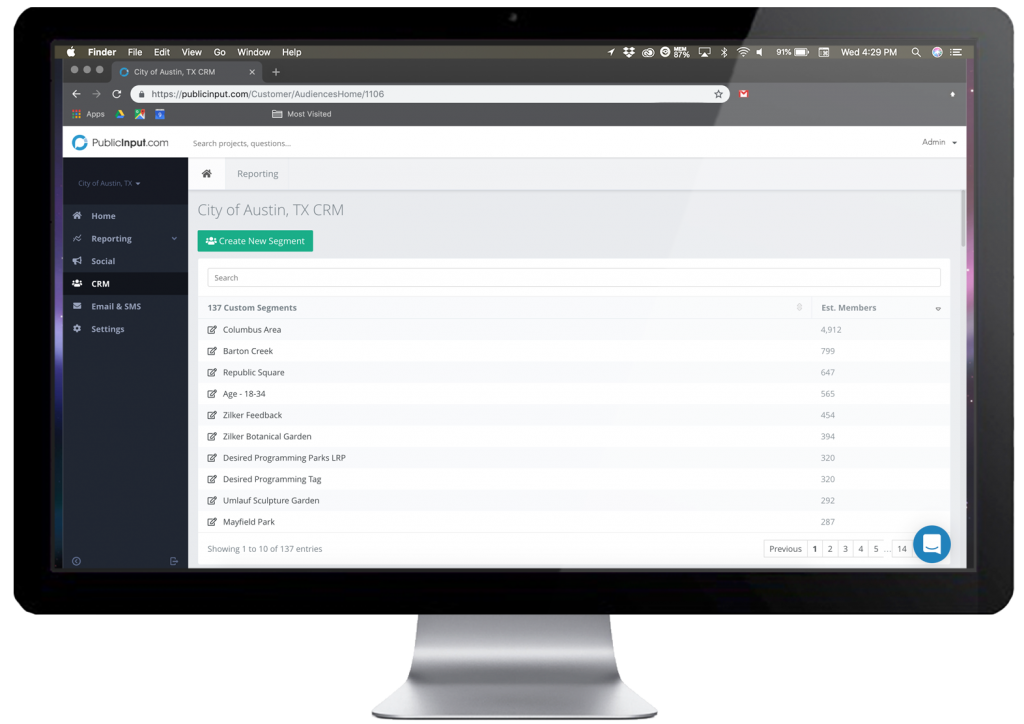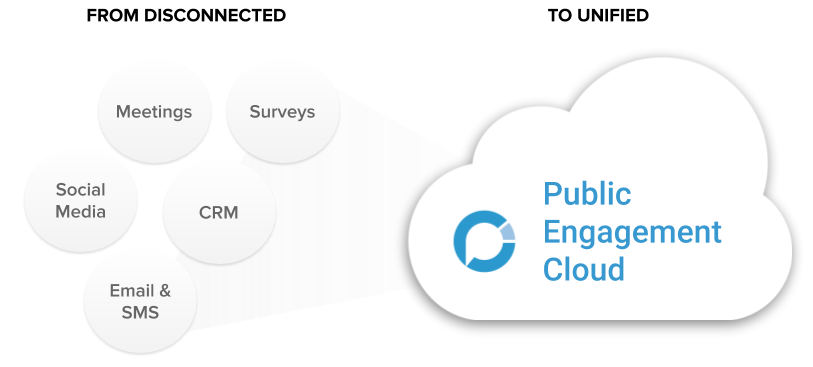You want public engagement on an upcoming project, so why not utilize an online survey? And what better than a long-standing, industry giant?
Using an online survey tool like SurveyMonkey may seem like a no-brainer, but as you might have experienced, just putting a survey out isn’t enough when it comes to the ultimate goal of creating public trust and a continuous cycle of public engagement.
The problem: Online survey tools like SurveyMonkey are not designed for public engagement – and can even undermine your success.
Start with your intention. When considering an engagement tool, it’s important to ask the following:
- Is our goal to reach more people, or hear more from a handful of people?
- What key information do we want to convey to residents?
- Do we want to create a transparent place for the exchange of viewpoints and ideas?
- How can we follow up with the people who took this survey?
Let’s dive a little deeper into why public engagement tools are different, and why public engagement software is increasingly the tool of choice for agencies.
Lowering Barriers to Participation and reaching beyond the usual voices
Ask: Is our goal to reach more people, or hear more from a handful of people?
Public engagement tools like PublicInput.com often see 5-10 times higher participation than traditional survey tools.
At first, this surprises agencies: Isn’t public engagement software focused on asking questions, much like a survey? To answer why this increase happens, consider both design and user experience.
One key tenet of public engagement software is lowering barriers to participation. Here is an example of how survey design makes a difference:

PublicInput.com is able to capture participate responses even if he/she does not press “Next” or complete a survey.
Informing and educating residents
Ask: Do we have any key information we want to convey to residents?
Creating public trust can start with sharing information and educating the public so that residents can make the most informed decision. On project websites, this might mean uploading photos, videos, and PDFs of relevant documents. This may also occur in the question creation itself – more dynamic questions like this one from a Durham, NC survey on affording housing:

Durham, NC was able to educate residents while gathering their input.
In this example, only 18% of survey participants were able to correctly identify a duplex – but after learning, went on to overwhelmingly support duplexes as a way to mitigate housing concerns in their neighborhoods.
Providing a transparent place for dialogue and discussion
Ask: Do we want to create a transparent place for the exchange of viewpoints and ideas?
Public engagement software contains conversations while still allowing residents to speak transparently. The ability to make responses public and instantly show response results helps create understanding as a resident progresses through a survey.
Likewise, the best public engagement tools are able to quantify public sentiment.
 You may have heard of visual results like a “noun cloud” or “word cloud” that show frequency of popular words and phrases. This is one way to better understand long-form comments, but what if you could understand the sentiment behind each popular word or phrase? That is what PublicInput.com can measure: the degree to which a word or phrase is referred to positively or negatively.
You may have heard of visual results like a “noun cloud” or “word cloud” that show frequency of popular words and phrases. This is one way to better understand long-form comments, but what if you could understand the sentiment behind each popular word or phrase? That is what PublicInput.com can measure: the degree to which a word or phrase is referred to positively or negatively.
Closing the loop with participants to build trust
Ask: Do I need to follow up with the people who took this survey?
Closing the feedback loop is a vital step to building public trust, but is often overlooked because of the extra leg work needed to do so – at least when using a survey-only tool.
This is because there isn’t a streamlined process that allows for easy follow up. You would first have to export a contact list, then import that list into a third party email tool, and may even have to create several different spreadsheets to put contacts into the right “buckets”.
Sound familiar?
These extra steps can often be enough to halt the follow up process, and require above average tech knowledge. However, a holistic software can relieve this friction all together.

With PublicInput.com, it only takes a couple clicks to organize contact information from survey participants and send a follow up email. Studies have shown that closing the feedback loop is the number one factor in increasing public trust – the way to truly build a relationship with your residents.
The bottom line – great community engagement means being able to:
-
Reach more residents by lowering the barrier to participation
-
Collect more data, instantly
-
Educate residents with dynamic content and questions
-
Allow residents to exchange views and ideas, which can be measured and quantified
-
Easily follow up with residents to close the feedback loop
Transcending the survey cycle: Collecting data vs. building a citizen database
When using a solution that is a stand alone survey tool, you get stand alone results. These one-off engagements may give insight into the project, but what happens when the next project comes along or you want to do a follow up survey?
You will likely find yourself right back where you started, hoping that a SurveyMonkey link will do the trick. However, the solution is not just collecting data, but creating a database of residents.
Public engagement software:
1. Maintains resident contact information and interests
For easy follow up and to send future, relevant surveys based on interests, location, demography, and prior meeting attendance. This also helps ensure that residents don’t “double dip” offline and online.
2. Aggregates all community engagement efforts in one place
Whether the survey was completed on a website, via text messaging, embedded in an email, or physically completed with a print survey.
3. Analyzes all the data to see the complete picture
By taking data out of “silos” created by using multiple platforms – and creating complete results that are visual and easy-to-share.
Ultimately, community engagement is about community re-engagement: You are in this for the short run and the long run.
Public engagement software makes data more meaningful
Online survey tools often lack dynamic questions. This is because these platforms were built primarily for customer service surveys and the occasional academic survey. For these purposes, online survey tools like SurveyMonkey work perfectly fine, but the question formats don’t allow for much outside of the typical multiple choice and short answer fields.
When it comes to getting meaningful data on public sentiment, perceptions, and opinions, survey questions need to have a more human touch. These include question types such as:
- Interactive Mapping Questions that allow residents to pinpoint locations
- Forum Questions where residents can be in conversation
- Ranking Questions that allow residents to indicate to what degree they place importance on options
- Slider Questions that allow residents to actively move a sliding scale from one extremity to another
- Auto-Detect Keywords that help agencies understand positive and negative attitudes toward desired keyword phrases – making sense of open-ended responses
Will moving away from SurveyMonkey mean losing what I already have?
Have a pile of old surveys scattered in spreadsheets and online survey tools like SurveyMonkey?
Each of these datasets has value – imagine how much more valuable they could be if you “de-siloed” them into one resident CRM.
PublicInput allows for easy upload of files exported from existing survey tools. When files are imported, matching projects and response records are instantly created. That means that every single survey question response from those prior surveys is captured and associated with each individual resident, who now have a profile on your CRM. Even better – now the same place where you launch surveys is also your database of citizen information and your email platform.

Goodbye siloed data, hello analytics and contact management. That’s the power of an all-in-one public engagement software.



